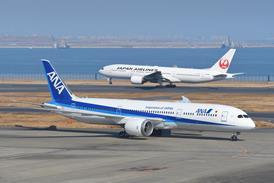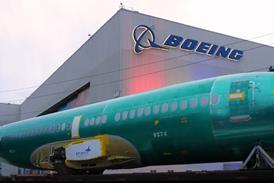Clive Beddoe and WestJet are taking a cautious approach to their expansion in eastern Canada
Forget about market share. Forget about filling the void left by Canada 3000's collapse. Forget about donning the mantle of Canada's number two airline, and growing to counter the dominance of Air Canada. Calgary-based WestJet - Canada's leading discount airline - has a more fundamental strategy.
Clive Beddoe, chief executive and one of WestJet's founders, explains it in simple terms: "We focus on what we do, and do it well...We don't pay attention to market share. We don't look at the competition very much. We just focus on our own business."
The strategy has apparently paid off, with the airline showing over 50% annual growth; 22 consecutive profitable quarters ; a 23% boost in profits (in the same year as the 11 September attack); a share price that has trebled in three years; and domestic market share of nearly 20%.
But WestJet earned its wings within the cosy, short-haul confines of western Canada. As it outgrows that niche and spreads east into more of Air Canada's traditional stronghold, questions arise. Can WestJet sustain its phenomenal growth? Can the airline cope with the challenges inherent in that growth, and what are its limits?
Domestic challenger
The November grounding and bankruptcy of Canada 3000 allowed Air Canada - which had already absorbed Canadian Airlines - to quickly capture 80% of the domestic market. It also thrust WestJet overnight into the position of Canada's second airline. Beddoe says this sudden sea change led several mid-sized Canadian communities to come begging for WestJet service, as "the last hope against Air Canada".
And Canadian cities were not the only ones courting the company. Foreign airlines seeking an alternative to Air Canada's steep prorates looked to WestJet for domestic feed and the oneworld alliance hoped WestJet might help fill the big blank space on its North American map. It appears that the only entity not so enthusiastic about WestJet growth is the carrier itself. "We have a pretty disciplined programme of growth," Beddoe says. "It is very tempting to accelerate growth. But if we grow too fast and can't keep pace, that becomes a major issue."
That said, WestJet has learned tobalance strict adherence to its business plan with the ability to take advantage of unforeseen opportunities.
After the failure of Canada 3000 - a combination leisure and scheduled carrier - WestJet picked up weekend charters for times when aircraft would otherwise have sat idle, and added some eastern Canada capacity to replace that flown by Canada 3000. But the opportunity with the most long-term significance was Toronto, Canada's biggest travel market and Air Canada's principal hub. "There was a demand for lower-fare service into Toronto," says Beddoe, "and the collapse of Canada 3000 opened up opportunities for us".
In May, WestJet launched flights to Toronto from Calgary and Edmonton. It has already boosted capacity to Canada's largest city to seven daily flights. Not only is Toronto Canada's "big apple", but having a presence in the city opens up the prospect of more flights from there into Quebec and the Maritime provinces.
"We can replicate in eastern Canada what we have done in western Canada in a heartbeat, and not even touch the depth of that market," Beddoe says. "Toronto is still small [for us] at the moment - more of a destination. But just looking at the population, it will clearly become a mini-hub."
Yet WestJet is showing restraint on other offers, having turned down oneworld and its foreign carrier suitors. Codeshares and interline prorates are not in WestJet's future, and clearance already received from Washington for scheduled flights to any US city will remain unused.
"Six months ago I said US service was two years away. Just looking atthe opportunities we have in Canada, Isuspect it is still two years away,"Beddoe says. "We need our own network in Canada. We need our own gathering system, and we need frequency on that gathering system in order to take the risk of going south."
"Disciplined but robust" best describes WestJet's growth within Canada. When the airline started six years ago, it had three Boeing 737s. Today it has 32, and before year-end will add seven more - four as replacements and three for growth, as WestJet phases out a fleet of 737-200s that at one point numbered 23. "We have a plan in place to run the -200s up to their D-checks," Beddoe says.
WestJet expects delivery of 10 737-700s next year and 11 more in 2004. By 2008, it should have up to 94 737-700s. With C$225 million (US$144 million) in cash and pre-delivery payments, as well as US Exim Bank guarantees, finance is no problem."We have flexibility," Beddoe says. "It depends on how aggressively we exercise the options."
Evolution
Until recently, WestJet's growth was evenly divided between adding new destinations, linking existing destinations and increasing frequencies. Beddoe says this pattern - which affords a comfortable balance to growth - "just evolved".
Now this balance is changing. WestJet and other short-haul carriers contend that a new C$24 security charge assessed on each round-trip has a disproportionate effect on shorter routes. The Canadian government has promised to review the rule by October, but Beddoe sees no clear signs of change, and is acting accordingly.
Saying that he is "not going to wait around," Beddoe has already cut back on WestJet's shortest - or "driveable" - flights, such as Calgary-Edmonton and Hamilton-Ottawa. He attributes a two-point drop in load factors on these flights to the new tax. At a recent news conference, he said: "We've spent many years building these short-haul routes and we're not going to walk away from them casually, but we won't put up with not making money."
Taxes may be to blame, but the other reason behind a stretch in WestJet's average stage length from 560-850km (350-530 miles) is the Next Generation 737s. "Canada has two significant population bases - one in eastern and one in western Canada," Beddoe says. "As we bridge them, our average will grow."
The 737-700 "opens a whole new potential for us", Beddoe adds. "That aircraft can effectively fly 5.5h in commercial use. The whole of the North American continent opens up to us - including Mexico and the Caribbean."
The Caribbean and Mexico do not figure in WestJet's plans, except as possible charters - but other changes do. One of the biggest is a move towards hubs. Beddoe dislikes the "H-word"; he and his partners built WestJet around a Southwest Airlines no-hub model. But the reality of WestJet's schedule is compelling the company to think again. With 70 daily flights, Calgary qualifies as a "mini-hub", according to Beddoe's definition. "Mini-hubs have evolved," he says, citing Calgary and Edmonton as cities that have earned the distinction, and Toronto, Hamilton and Winnipeg as likely candidates to join them.
Growth has brought other changes. Moving from 737-200s to -700s was, Beddoe says, "a massive adjustment", - requiring "training our maintenance staff, our pilots, bringing in the simulators and bringing in facilities to support them".
Joining global distribution system Sabre early this year was another big step. "We didn't want to do that, but gradually we found that we had to give it a try," he says. "Sabre now represents a significant portion of our bookings." Not without problems, however - Beddoe reveals that the new booking system required "massive rewrites".
Other growing pains include a recently begun transition from third-party to in-house ground handling at Calgary, and a continuing search to find the right people from within its 50,000-strong workforce to lead it into the future. Beddoe says: "The strength of WestJet comes from having an integrated team of very capable people, providing them with the resources they need and winding them up and letting them go."
Beddoe recognises that WestJet is nearing the end of its fast growth. "We cannot maintain a 50% yearly growth rate," he says. "The compounding effect becomes too great. That percentage will gradually decline as we get bigger. Next year my guess is it will be in the mid-40s; the year later perhaps the low 40s or high 30s." Overall, the rate may slow, but in eastern Canada, WestJet's growth has only just begun.
Source: Airline Business























